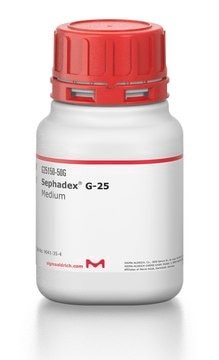GE17-0851-01
Disposable PD 10 Desalting Columns
Cytiva 17-0851-01, pack of 30 pieces
Synonym(s):
Disposable desalting columns, PD-10 columns
About This Item
Recommended Products
feature
wetted part: no
packaging
pack of 30 pieces
manufacturer/tradename
Cytiva 17-0851-01
storage condition
dry media
bed size
14.5 mm × 50 mm
bed volume
8.3 mL
column I.D.
15 mm
matrix
cross-linked dextran
particle size
>50 μm (dry)
85-260 μm
cleaning
2-13
working range
2-13
suitability
suitable for bioprocess medium
Related Categories
General description
The instructions for Disposable PD-10 Desalting Columns have been updated with two new application protocols: gravity or centrifugation, to increase the flexibility of the product. The gravity protocol allows a simple cleanup of samples with one or several columns in parallel, without the need for a purification system. The spin protocol enables runs in parallel in a standard centrifuge with minimal dilution of the eluted sample.
Four adapters are included in each product pack to enable easy centrifugation. Together with LabMate PD-10 Buffer Reservoir, wash and equilibration buffer can be applied in one step with the gravity flow protocol. Empty PD-10 columns are recommended for use with bulk media for affordable and versatile sample preparation.
Features and Benefits
- Fast, affordable, high-recovery desalting and buffer exchange, as well as removal of low-molecular weight compounds packed with Sephadex® G-25 Medium.
- Flexible protocols allow runs by gravity flow or centrifugation.
- Easy to use and equilibrate; apply sample; elute.
- Preparation of the samples in the range of 1.0 to 2.5 mL by gravity flow and 1.75 to 2.5 mL with centrifugation.
- Desalt multiple samples in parallel with a desalting capacity >90%.
- Recovery in the range 70 to >95%.
Storage and Stability
Legal Information
also commonly purchased with this product
Signal Word
Warning
Hazard Statements
Precautionary Statements
Storage Class Code
12 - Non Combustible Liquids
WGK
WGK 3
Flash Point(F)
Not applicable
Flash Point(C)
Not applicable
Certificates of Analysis (COA)
Search for Certificates of Analysis (COA) by entering the products Lot/Batch Number. Lot and Batch Numbers can be found on a product’s label following the words ‘Lot’ or ‘Batch’.
Already Own This Product?
Find documentation for the products that you have recently purchased in the Document Library.
Customers Also Viewed
Articles
GST-tagged protein yield varies based on protein, host cell, and culture conditions, influencing production.
GST-tagged protein yield varies based on protein, host cell, and culture conditions, influencing production.
GST-tagged protein yield varies based on protein, host cell, and culture conditions, influencing production.
GST-tagged protein yield varies based on protein, host cell, and culture conditions, influencing production.
Protocols
This page shows how to separate IgG antibodies by affinity chromatography using Protein G GraviTrap from Cytiva.
This page shows how to separate IgG antibodies by affinity chromatography using Protein G GraviTrap from Cytiva.
This page shows how to separate IgG antibodies by affinity chromatography using Protein G GraviTrap from Cytiva.
This page shows how to separate IgG antibodies by affinity chromatography using Protein G GraviTrap from Cytiva.
Our team of scientists has experience in all areas of research including Life Science, Material Science, Chemical Synthesis, Chromatography, Analytical and many others.
Contact Technical Service









